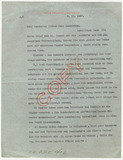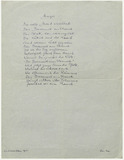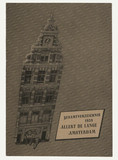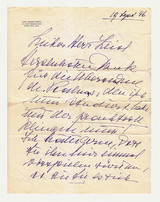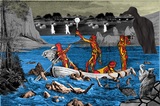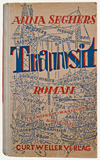Alfred Neumeyer: Letter to Oskar Kokoschka, carbon copy (8 February 1937)
In February 1937 Alfred Neumeyer thought that he would soon become personally acquainted with the painter Oskar Kokoschka. Neumeyer had asked the artist, who was living in exile in Prague, to conduct a summer school at Mills College in California.
Alfred Neumeyer: Magie, manuscript (Christmas 1945)
In June 1935, Alfred Neumeyer was excluded from the Reich Literature Chamber because of his Jewish ancestry. The Nazis had already tried to frustrate his promising initial success as an author.
Allert de Lange Publisher: Complete catalog 1939
In 1933 a new German language department was opened in the renowned publishing house Allert de Lange in Amsterdam. Numerous German titles were published until 1940, above all the works of exiled authors.
Alma Mahler-Werfel: Letter to Eric Zeisl (19 September 1946)
Alma Mahler-Werfel wrote from 610 N. Bedford Drive, Beverly Hills, Los Angeles.
andcompany&Co: Orpheus in der Oberwelt. Eine Schlepperoper (2015)
The work of the Andcompany&Co. artist collective is often about boundaries.
Angelika Domröse: Still photograph from the film Die zweite Haut (1981)
A DEFA project only possible in the westAfter leaving the DDR together the actors Angelica Domröse and Hilmar Thate, a married couple, filmed their first movie for West Germany broadcaster “Westdeutscher Rundfunk” in 1981. Under the DEFA director Frank Beyer, who had fallen into disgrace in the GDR but who possessed a work permit for the Federal Republic of Germany, they took the main roles in Die zweite Haut (The Second Skin), a marital drama with a screenplay by the writer Klaus Poche who had himself emigrated from the East in 1979.
Angelika Domröse: Still photograph from the film Verfehlung (Misconduct) (1991)
Return of an exile to DEFAImmediately after the fall of the wall Heiner Carow, who had repeatedly challenged the GDR leadership as the director of such thematically provocative films such as Die Legende von Paul und Paula (The Legend of Paul and Paula, 1973) and Coming out (1989), began preparations for one of the last DEFA productions. The material, a tragic love story between an East German cleaning lady and a West German port worker, was also a personal farewell to the now defunct GDR.
Anna Riwkin-Brick: Dancer Jula Géris (Jula Isenburger) (1936)
Before going into exile, Jula Isenburger, alias Jula Géris, worked as a solo dancer at the Salzburg Festival, at the theatre of Max Reinhardt as well as at the dance theatre of Mary Wigman. In exile in France she was initially a member of a local dance group and later became a solo dancer.
Anna Seghers: Das siebte Kreuz [The Seventh Cross (1942)], first German edition, published in Mexico (1942)
Book production under adverse conditionsThe El Libro Libre publishing house, which published the first German-language edition of Anna Seghers’ novel Das siebte Kreuz, had been established in May 1942 by German writers and intellectuals who were in exile in Mexico.
Anna Seghers: Transit (1948)
Anna Seghers’ novel Transit is one of the most important literary works focusing on exile as its theme, in which the author worked through the impact of her own escape. It was written from 1941 to 1942 and was published initially in 1944 in English and Spanish.
